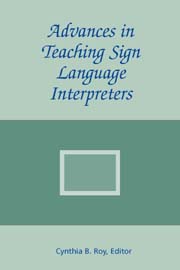Cynthia B. Roy, Editor
Foreword by Franz Pöchhacker
|
View the table of contents. View the list of contributors. Read the foreword. Read the introduction. Read an excerpt. Read a review. |
$63.25s print edition $63.25 e-book |
Interpreter Education, Volume 2
From Interpreting, International Journal of Research and Practice in Interpreting
In recent years, scholarly interest in interpreting studies has moved towards broader horizons beyond spoken simultaneous and consecutive conference interpreting to embrace new forms of interlinguistic communication emerging in response to the rapid transformations underway within our modern societies. Running in tandem with spoken-language interpreting studies are those studies concerned with signed languages. Cynthia B. Roy’s edited volume addresses issues of pedagogical methodology and new approaches to teaching sign language interpreting in the classroom.
Roy, a renowned American professional sign language interpreter, interpreter trainer and associate professor, has brought together ten contributions which offer fresh ideas and detailed descriptions of learning activities provided by influential educators involved in sign language interpreter training essentially in the United States (six contributions), but also one from Australia and three from Europe (UK, Belgium and Sweden). Unfortunately, there is no preface to introduce the collection, so its genesis (workshop, conference, random selection) and the intent of the editor remain unclear. Nor is there a postscript. Bibliographic references are added to each paper rather than in a single list at the end. However, an analytical index of key words is provided.
The volume begins with Dennis Cokely reporting on changes made in 2003 to the curriculum of the American Sign Language Program at Northeastern University in Massachusetts. Previously, educators there had followed a skill—set approach to teaching interpreting based initially on translation, followed by consecutive and simultaneous interpretation respectively utilizing a monologic discourse approach (dominant in the US since the 1980s). Recourse to expository discourses from international conferences ignored the real communicative needs of d/Deaf people in everyday dialogic situations, which were documented in a six-month survey of interpreter assignments: one-to-one interactions, small-group interactions, and large-group interactions. In the light of findings, changes were made to the curriculum in order to focus on the most commonly encountered dialogic situations pinpointed in the survey: inquiry interactions, narrative interactions, expository interactions and persuasive interactions.
Cynthia B. Roy is a retired professor in the Department of Interpretation and Translation at Gallaudet University, where she directed the BA program and the PhD program. She is also a nationally certified American Sign Language–English interpreter specializing in community interpreting.
Print Edition: ISBN 978-1-56368-320-6, 6 x 9 casebound, 224 pages, tables, figures, references, index
$63.25s
E-Book: ISBN 978-1-56368-391-6
$63.25
To order by mail, print our Order Form or call:TEL 1-800-621-2736; (773) 568-1550 8 am - 5 pm CST
TTY 1-888-630-9347
FAX 1-800-621-8476; (773) 660-2235
